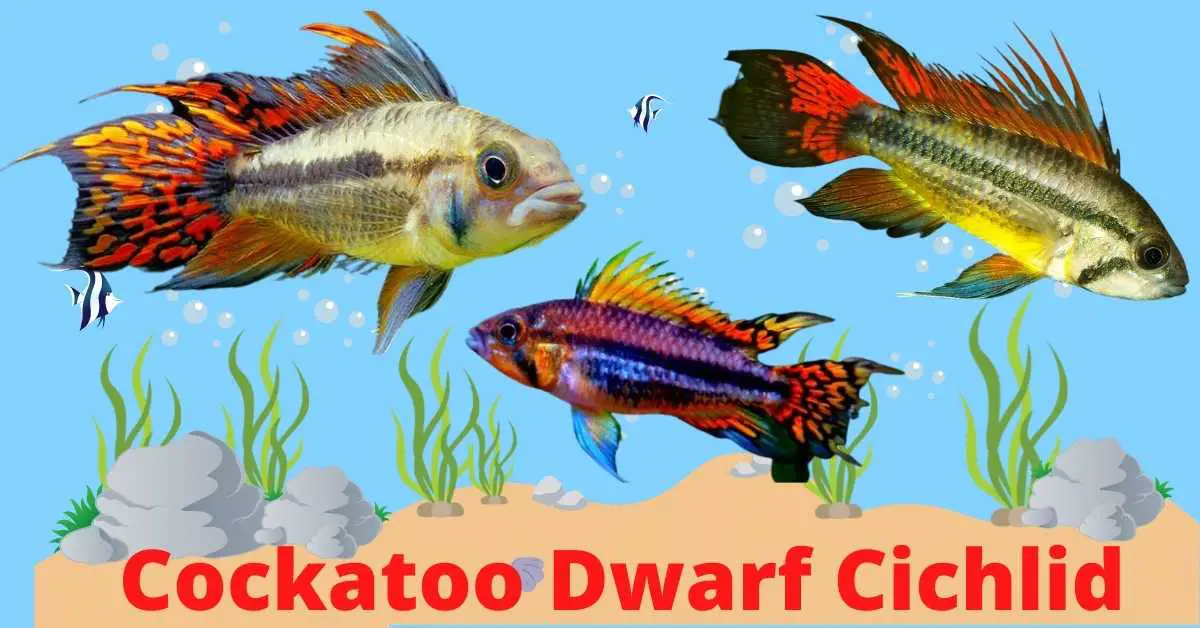Cockatoo cichlid (Apistogramma cacatuoides) is a popular aquarium fish which is also known as the Cockatoo dwarf cichlid, Cockatoo dwarf, or Cockatoo Apisto. The Cockatoo Dwarf Cichlid is named after its beautiful coloration, being similar to Cockatoos. It is a freshwater fish from South America, where it is found in the Amazon basin, Rio Negro, the Atlantic coast of South America, and south to Paraguay and Brazil. It is a species of fish in the family Cichlidae under order Cichliformes. It is one of the world’s most popular dwarf cichlids. Their natural habitat is streams, lakes, and ponds with rocks or gravel substrate. They swim in pairs or trios and form lifemates.
Systematic Position
Phylum: Chordata
Subphylum: Vertebrata
Class: Actinopterygii
Order: Cichliformes
Family: Cichlidae
Genus: Apistogramma
Species: Apistogramma cacatuoides
Physical Description of Cockatoo Dwarf Cichlid
It is a colorful and peaceful fish. This fish can be attributed to the black bars on its flanks which are vertical instead of horizontal. It can be kept in small community tanks with other peaceful species that are smaller than itself.
It is a small-sized fish in the Cichlid family and it is called a dwarf cichlid because males attain a size of 2.5 inches in length while females reach a slightly smaller size of 2 inches in length.
It has a silvery-blue body with a yellow to orange tail and along the ventral area of the body is white. The male will have a light blue patch on its anal fin, which makes it easy to identify during spawning.
Habitat Requirements of Cockatoo Dwarf Cichlid
The shy nature of this little fish means its requirements are fairly simple, making it a great choice for beginning aquarists. To keep Cockatoo cichlid happy and healthy, you need an aquarium that’s at least 20 gallons with lots of hiding places and open swimming space.
The cockatoo dwarf cichlid is a relatively new Apistogramma species to the aquarium trade.
It is a peaceful and non-aggressive fish. It can be kept in a small group with other small fish. Like the other dwarf cichlids, it may tend to be territorial and requires watching when putting other fish in its tank. Only place one male into the aquarium. As with most Apistos, little is known about their breeding habits in the wild. Like all Apistogramma dwarf cichlids, it is an egg-scatterer that provides no care for the eggs or fry.
They are great jumpers so take care when setting up your tank. The Cockatoo dwarf cichlid will eat most flake and pellet food and should be allowed to swim and forage for plants and algae in your tank.
Many features make the cockatoo cichlid very popular among aquarists:
• They are active and can “talk” (with significant noise);
• Their body shapes and coloration make them one of the most attractive Apistogramma species;
• They can easily create families due to their peaceful and quiet behavior;
• They do not make pollution in the aquarium as a result you may keep your tank clean easily.
After all, cockatoo dwarf cichlid is relatively inexpensive to care for, easy to feed, fairly peaceful, and fairly easy to breed. The fish is popular among aquarium enthusiasts because it is exceptionally pretty and tolerant of a wide range of water conditions. It requires soft water with a pH of 7.4-7.6, a temperature of 26 0C and a hardness of 3-10 dGH. It can live for about 4 to 5 years. They are well-suited for aquariums with moderate currents and rocky bottoms.

